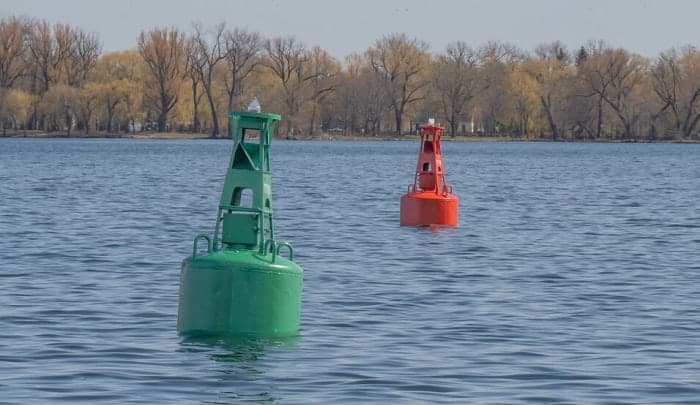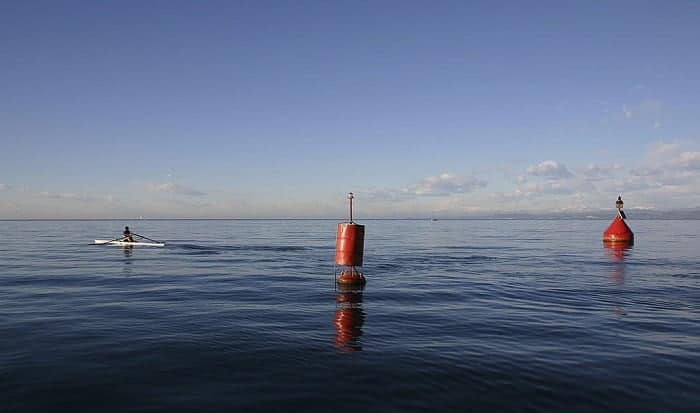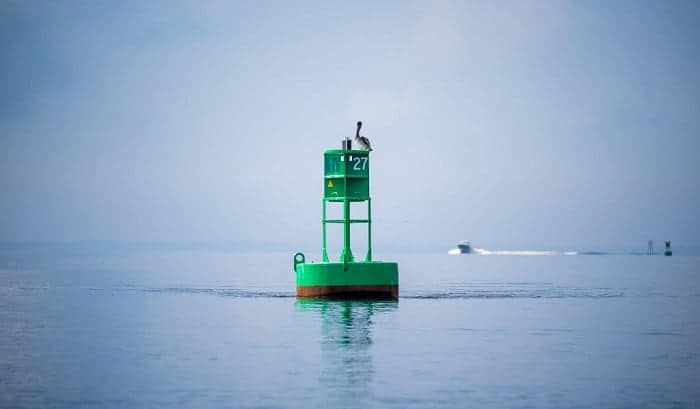- Red markers – starboard-side channel marker
- Green markers – port-side channel marker
- Red and Green markers – diverging channel indicator
Water markers have distinct features that make them easily recognizable. However, knowing them all is difficult, regardless of how easy they are to spot.
Red and Green markers are among the most easily recognizable water markers. Knowing what do the red and green markers indicate is a big step in navigating your way through the open waters.
Keep reading and learn one of the easiest ways to keep your bearings out at sea.
Table of Contents
What Are Red And Green Water Markers?
First, let’s clarify, red and green water markers refer to lateral markers. These are the starboard hand marker, the port hand marker, and the bifurcation marker.
Lateral markers are a type of water marker that marks the boundaries of the water to indicate a channel or waterway. They indicate the section of water that is established for the passage of water vessels and is thus considered safe water.
Aside from establishing waterways, they are also used to aid in navigating and directing traffic on the water. Red and green mean specific things, along with other indicators on these markers such as numbers and sometimes even shapes.
Below, we’ll discuss each of these markers in more detail.
What the Red and Green Markers Indicate
The red and green markers are the most basic boating markers. These are easy to use and you only need to use one of them, depending on where you are going, whether you are going back to shore or you are headed to the open water.
1. Red Marker
Red markers are what we call starboard hand markers. A starboard hand marker is used as a reference when going upstream. We use the starboard hand side of the channel, indicated by these red markers, and keep them on the starboard side or the right side.
Aside from their color, we can also see numbers on these markers. For the starboard hand markers, the numbers are always even and the number goes higher the further upstream we go.
Another indicator that can be found on red markers is a triangle, but these are only used for day markers. Day markers are like traffic signs along the side of the road. They are fixed to solid ground with a post.
2. Green Marker
Green markers are called port hand markers. Since red markers are used as references when going upstream, we can infer that green markers are references for when we are going downstream. We keep them on the starboard side when going downstream, similar to red markers when heading upstream.
These green markers, along with red markers, are the standard marker pair for establishing a waterway or channel.
Similar to red markers, green markers also have a number on each one, but odd numbers are used instead. Also similar to red markers, the number goes higher the further upstream we go.
Green markers can also have a shape as an indicator; this is the square. Also similar to red markers, we see these only for day markers.
3. Red and Green Marker
There is also a buoy with red and green bands. This is called the bifurcation marker and serves as the indicator for diverging water channels.
While all bifurcation markers serve the same purpose, there are slight variations between them — the distribution of red and green may differ. While the differences in the color of the body can be inconsequential, it’s the top that we have to pay close attention to.
The top of a bifurcation marker will be of a single color, red or green. This color refers to the preferred channel between the two channels where the waterway diverges. For example, if the top is red, then the side with the red marker is the preferred channel while the other is the secondary channel.
As for which marker to use as the reference for identifying the preferred channel, you should refer to the ones closest to the bifurcation marker. There should be one of each color, red and green, to the right and left of the bifurcation marker. These are your references.
Other Important Markers To Know
1. Safe Water Marker
These are red and white markers that indicate an area of water is safe for passage. They are usually found in the middle of a water channel, so it’s a good idea to know what they are there for to prevent any confusion.
2. Mooring Buoy
Mooring buoys are not just for indicating something, they are also functional. These are used to indicate a recommended place for mooring to prevent large vessels from hitting the sea bed.
They are also used for mooring to help avoid the need for deploying anchors. These are usually used in areas with corals because deploying anchors damage the corals and the sea bed, leading to the destruction of fish habitat.
As for mooring buoy colors, they are white with orange stripes. There are different types of mooring buoys, however, and they can be complicated to use depending on the type.
Important Terms
1. Upstream
This refers to the flow of water. Water flows toward the sea or ocean; therefore, upstream means against the flow and is the direction towards land. Saying upstream when referencing a red buoy meaning means we are going back to shore or heading inland.
2. Downstream
Since upstream refers to the direction against the flow of water, downstream refers to following the direction of the flow of water. We refer to downstream when referencing a green buoy meaning when we are heading for the sea or ocean.
3. Preferred Channel
Preferred channel refers to the side of a diverging channel that is bigger or wider of the two. The other channel is called the secondary channel.
Conclusion
Now you know all about red and green markers, including what do the red and green markers indicate along with other important information.
Water markers are an essential part of boating and one you should not take for granted. Hopefully, this short guide was able to help you get started on learning such a vital tool for navigating the open water.
If you found this guide helpful, please share it and leave your comments below. Happy boating.

“I am James Harvey – founder of Boating Basics Online. It is established with the drive to help out first-time boaters, which are those desiring to explore their way through the water. So if you are new to boating, start from here with me. “



